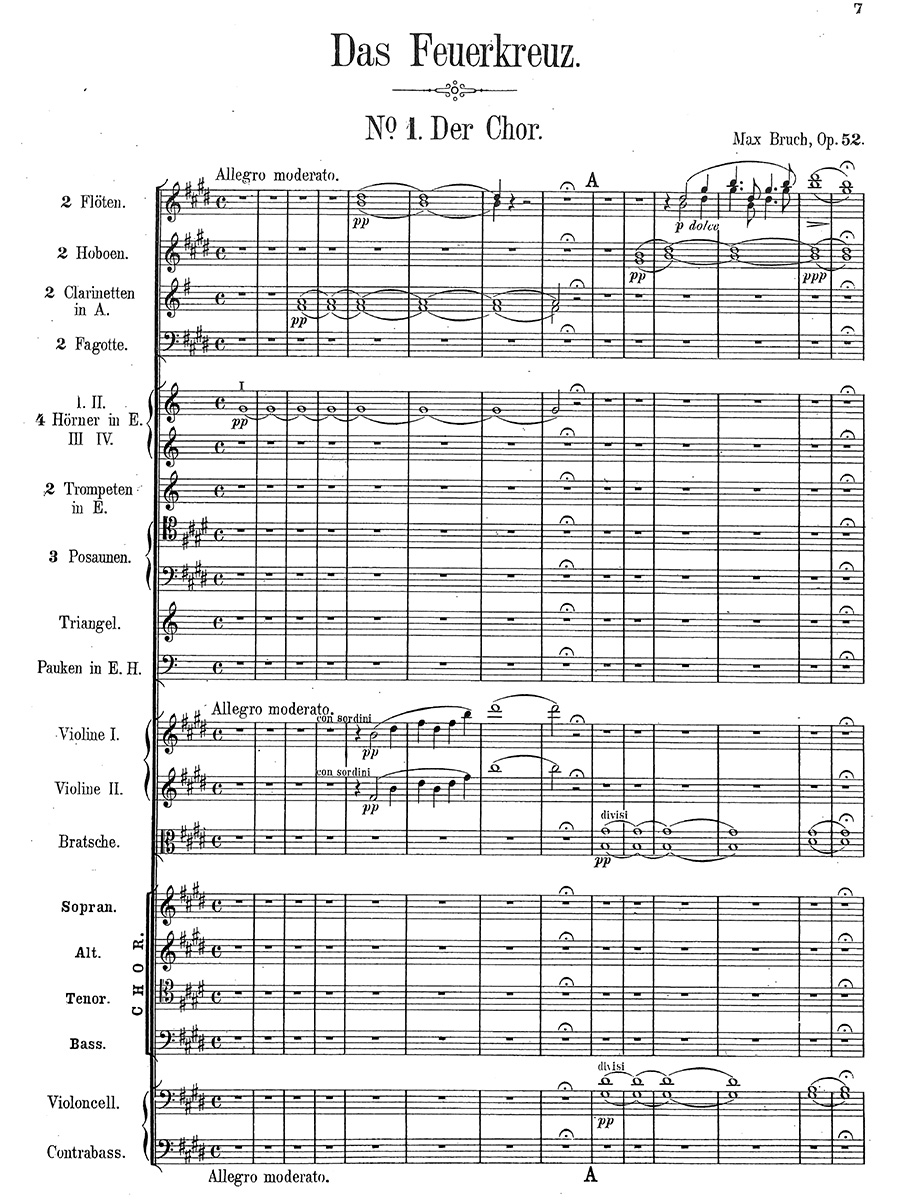Das Feuerkreuz Op. 52 (The Fiery Cross), Cantata for soprano, baritone, bass, mixed chorus, and orchestra
Bruch, Max
50,00 €
Preface
Max Christian Friedrich Bruch
The Fiery Cross (Das Feuerkreuz, op. 52)
A cantata for soprano, baritone, bass, mixed chorus, and orchestra, op. 52
January 6, 1838 (Cologne (Köln), Rheinprovinz, Königreich Preußen) – October 20, 1920 (Friedenau)
First Performance
26 February 1889 in Breslau
Preface
Max Bruch was a German composer who wrote over 200 works, notably his moving Kol nidrei for cello and orchestra, op. 47, and the first of his three violin concertos (Violin Concerto No. 1 in G minor, op. 26 (1866), which has become a staple of the violin repertory. Although he was raised Rhenish-Catholic, the National Socialist party banned his music from 1933-1945 due to his name, his well-known setting of a melody from the Jewish Yom Kippur service, and his unpublished Drei Hebräische Gesange for mixed chorus and orchestra (1888).
Bruch was also an accomplished teacher of music composition from 1892-1911, conducting seminars and ensembles at the Royal Academy of Arts at Berlin (Königliche Akademie der Künste zu Berlin). British composer Ralph Vaughan Williams studied with Bruch, describing him as a proud and sensitive man. Bruch actively resisted the Lisztian/Wagnerian musical trends of time, and modeled his works on those of Mendelssohn and Schumann. His concerti share structural characteristics with Mendelssohn’s Violin Concerto in E minor (omitting the first movement exposition and linking multiple movements). His most lasting contributions to chamber music include works written for his son Max, who was a clarinetist.
Child Of His Time
Bruch was born in the same decade as Johannes Brahms, Georges Bizet, and four of the Russian Five or “Mighty Handful” (Могучая кучка). At the age of fourteen (1852), he was awarded the Mozart Prize of the Frankfurt-based Mozart Stiftung, which enabled him to study with virtuoso Ferdinand Hiller. In 1858, he moved on to Leipzig and then held posts in Mannheim (1862-1864), Koblenz (1865-1867), and Sondershausen (1867-1870).
He held several prestigious positions, directing the Liverpool Philharmonic (1880-1883) and leading notable concerts in Berlin and northern German cities. He went on an American tour, directed singing societies, and continued to compose for men’s chorus (Kriegsgesang, op. 63 and Leonidas, op. 66, 1894-1896); and for mixed chorus (over twenty more works in German dating from the 1870s through his last choral work in 1919: Trauerfeier für Mignon, op. 93 (after Goethe).
Beginning in his early twenties, he received commissions for chorus, orchestra, and soprano solo such as Jubilate Amen, op. 3 (1858) and Die Birken und die Erlen, op. 8 (songs of the forest for men’s and women’s choruses with soloists, 1859). Even at this early period, Bruch showed a preference for ancient literary material. Works like Frithjof: Szenen aus der Frithjof-Sage, op. 23 (1864), an oratorio based on a thirteenth-century Icelandic saga which the Swedish poet Esaias Tegner had reworked as an epic poem in 1820, were well-received by audiences. After its premiere in Vienna, one reviewer observed, “Its success can be measured by the deafening applause after each scene, and the recall of the composer three times at the end.”
At the time of the composition of Die Birken, Max Bruch followed Hiller’s advice, and planned to travel to Leipzig (early 1858). With its famous Conservatory, the Gewandhaus Orchestra, and its internationally respected music publishers such as Senf, Kistner, and Breitkopf & Härtel, Leipzig was a center of considerable significance. Although the Gewandhaus was under the direction of Julius Rietz at this time, the influence of Mendelssohn and Schumann still dominated the musical life of the city.
Just before arriving in Leipzig, the twenty-year-old Bruch had supervised the first staging of Scherz, List und Rache in Cologne (Köln), and had participated in an extensive “farewell” concert on 4 November 1857 in the Hotel Disch. The cantata for soprano, chorus, and orchestra Die Birken und die Erlen, op. 8 was the largest work featured.
Read full preface / Komplettes Vorwort lesen > HERE
Score Data
| Edition | Repertoire Explorer |
|---|---|
| Genre | Choir/Voice & Orchestra |
| Size | 210 x 297 mm |
| Printing | Reprint |
| Pages | 260 |
